List of National Treasures of Japan (Residences)

Since 1897, designated “ material cultural goods ” can also be elevated to national treasures in Japan . The definition and criteria for a national treasure have changed over time. All of the residences listed here meet the current provisions of the Cultural Property Protection Act , which has been in force since June 9, 1951. The appointment to the national treasure occurs because of the "particularly high historical or artistic value" and by the Minister of Education .
The list includes fifteen residences from the feudal period of the 15th century ( Muromachi period ) to the early 17th century ( Edo period ). The listed buildings and architectural structures include teahouses, shoin (study and reception room), entrance areas, and other spaces that were parts of upscale Japanese homes . Most of them were in temples, one national treasure is a castle . In 2009 Akasaka Palace was named a National Treasure in the Modern Residences category . As it is the only national treasure in this category, it is listed here along with the older structures.
The foundations for the construction of traditional Japanese residences with tatami floors of the present were developed in the late Muromachi period and refined in the subsequent Momoyama period . From the architectural style of the castles in the early Heian period and the architectural style preferred by the samurai class in the Kamakura period, the Shoin-zukuri architectural style developed under the influence of Zen Buddhism in the Muromachi period . The term shoin ( 書院 ), literally study or writing room, usually referred to both the reception room in the apartments of the military elite and the work room in monasteries.
A shoin consisted of a central main room, which was enclosed by corridors and which could be divided by sliding doors ( fusuma ) or by room dividers ( shōji ). The main reception room was usually equipped with a decorative niche, a tokonoma with shelf-like, offset shelves and elaborately painted sliding doors. Usually the reception room is complete; H. from wall to wall, covered with tatami mats, is equipped with square pillars and a coffered ceiling and has wooden sliding doors that protect the room as rain doors ( 雨 戸 , amado) in rainy weather. An entrance area ( genkan ) developed as a component of residential buildings only in the Momoyama period. The oldest in the Shoin style built and still preserved building is the Tōgu-dō in Ginkaku-ji from 1485. Further representative examples of the early Shoin style, also called Shuden style, are two large visitor rooms in the Mii-dera . The Shoin architectural style reached its peak in the early Edo period. At the same time it spread as an architectural style for residences for the military elite. The somewhat more formal style of this era can still be seen in the Ninomaru Palace, Nijō Castle and Nishi Hongan-ji .
In addition to the shoin-zukuri , a simpler design developed for Japanese teahouses, which were used for the tea ceremony (chadō) . In the 16th century, the Sen no Rikyū and usually its small size of two to eight tatami mats, the use of natural materials and its rustic appearance because of the reed hut ( 草庵 , sōan ) called tea house established itself. This form of tea house, of which the Joan and Taian tea house are exemplary, had characteristics of both the Japanese farmhouse and the shoin style: it had tatami mats, a tokonoma niche and one or more antechambers for preparations for the tea ceremony.
At the beginning of the Edo period , the equipment features of the Shoin style were mixed with those of the tea houses. This led to the sukiya-zukuri style ( 数 寄 屋 造 ), a less strict construction and variant of the Shoin style. In sukiya-zukuri , cedar, pine, fir, bamboo and cypress wood were mostly used with a rough surface and with the bark. In contrast to the Shoin style, the eaves in the sukiya construction were curved downwards. The Shoin style was suitable for magnificent buildings, but became too pompous for residences. Consequently, with the beginning of the Edo period , houses for the nobility and samurai were built in the sukiya style. Examples of this type of construction are the imperial Katsura villa and the Kuroshoin ( 黒 書院 , black study hall ) of Nishi Hongan-ji .
Key figures
A total of 15 buildings in ten places in five cities are listed below. Ten of the 15 buildings are in Kyoto . Most of the national treasures in the residences category are owned by the three buildings of Nishi Hongan-ji .
|
|
Legend
The columns in the table below can be sorted, with the exception of the Notes and Image columns.
- Designation : Designation of the structure according to the database for national cultural assets.
- Building complex : Usually the building is part of a building complex (a temple complex, for example), which is referred to here.
- Notes : general and architectural notes, such as dimensions and architectural features.
- Period : Period of construction, sorted by year. If no exact date is known, the year in which the period begins is given here.
- Location : city, prefecture and geographic coordinates of the building, sorted by prefectural name.
- Image : Figure of the residence.
National treasures
| designation | Building complex | Remarks | Time period | Location | image |
|---|---|---|---|---|---|
| Tea House Joan ( 如 庵 ); appointed 1951 | Urakuen ( 有 楽 苑 ) | Japanese tea house , one-story , hipped foot roof irimoya-zukuri ( 入 母 屋 造 ) covered with clapboards , tea house with 2.5 + 3/4 tatami mats and a preparation room (mizuya) with three tatami mats , built by Oda Uraku, a student of Sen. no rikyu |
early Edo period , ca.1618 |
Inuyama , Aichi Prefecture |
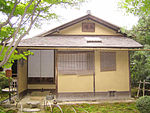
|
| Kangakuin, reception area ( 勧 学院 客 殿 , kangakuin kyakuden ); appointed November 22, 1952 | Mii-dera | Front: seven Ken × page: seven Ken , Fußwalmdach (East Asian hip-and-gable roof-zukuri) , entrance in Tsumairi style, wavy, convex verge karahafu ( 唐破風 ) on the front, here as norikarahafu ( 軒唐破風 ) d. H. starting at the eaves , executed; Gable roof in the kirizuma-zukuri style ( 切 妻 造 ) with the same gable length from the roof ridge to the eaves, covered with wooden shingles on one level. | Momoyama period , 1600 | Ōtsu , Shiga Prefecture 35 ° 0 ′ 42.4 ″ N , 135 ° 51 ′ 8.6 ″ E | |
| Kōjōin, reception area ( 光 浄 院 客 殿 , Kōjōin kyakuden ) | Mii-dera | Front: seven Ken × page: six Ken , Fußwalmdach (East Asian hip-and-gable roof-zukuri) , input in tsumairi style, wavy, convex verge karahafu ( 唐破風 ), saddle roof in kirizuma Zukuri style ( 切妻造 ) with the same gable length from the roof ridge to the Eaves., One story covered with wooden shingles. | Momoyama period , 1601 | Ōtsu , Shiga Prefecture | |
| Kanchiin, reception area ( 観 智 院 客 殿 , Kanchiin kyakuden ) | Tō-ji | Front: 12.7 m × side 13.7 m, entrance in tsumairi style, karahafu ( 唐 破 風 ) on the front, here as norikarahafu ( 軒 唐 破 風 ) d. H. starting at the eaves , executed; Gable roof in the kirizuma style ( 切 妻 造 ) with the same gable length from the roof ridge to the eaves, one-story covered with copper sheet. | Momoyama period , 1605 | Kyoto , Kyoto Prefecture |
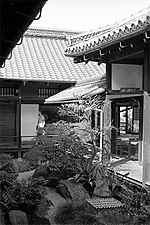
|
| Reception and study ( 表 書院 , Omote shoin ) | Sanbo-in | Includes a lower, middle and upper room; the lower (gedan) could function as a no- stage, with the audience sitting in the middle and upper room. Size of the upper room: 15 tatami mats (with tokonoma ), anteroom 27 mats, entrance from all four sides, one-story, irimoya style, spring well ( 泉 殿 izumidono ) in kirizuma style, roof covering: sangawarabuki , canopy on the west side as performed karahafu and covered with cypress bark . | Momoyama period , 1598 | Kyoto , Kyoto Prefecture |

|
| Karamon ( 唐門 ) | Sanbo-in | Gate with the dimensions: 3 × 2 ken, passage in the middle (6.27 × 2.60 m) verge in karahafu style; is also called chokushimon ( 勅使門 , gate for Imperial messengers ) called, was completely painted black with four large chrysanthemum and paulownia motifs decorated, covered with bark of Hinoki cypress | Momoyama time | Kyoto , Kyoto Prefecture |

|
| Silver Pavilion ( 銀 閣 , Ginkaku ) | Ginkaku-ji | East and west side: 8.2 m, north side: 7.0 m, south side: 5.9 m, two-storey: ground floor in shoin-zukuri style, first floor in the style of Chinese temples with windows, with the window arch "S" on both sides -shaped, curved ( 火 灯 窓 , katōmado , Katō window arch ); Roof in hōgyō style covered with roof shingles, original name: Kannonden ( 観 音 殿 ) | middle Muromachi period , 1489 | Kyoto , Kyoto Prefecture |
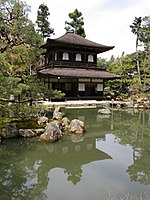
|
| Tōgu-dō ( 東 求 堂 ) | Ginkaku-ji | 6.9 × 6.9 m, one-story, irimoya style, covered with bark of the Hinoki cypress , Buddhist hall for Ashikaga Yoshimasa with two Buddhist prayer halls and two other rooms; The oldest surviving building in the shoin-zukuri style | late Muromachi period , 1485 | Kyoto , Kyoto Prefecture |
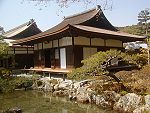
|
| Guardroom ( 遠 侍 , Tōzamurai ) and covered car driveway ( 車 寄 , kurumayose ) | Ninomaru Palace ( Nijō Castle ) | Entrance hall: 5 × 3, roof covering with Hinoki cypress bark Guard room : 8 × 8, roofing in the hongawarabuki style, |
early Edo period , 1602–1603 and 1625–1626 | Kyoto , Kyoto Prefecture |

|
| Entrance area ( 式 台 , Shikidai ) | Ninomaru Palace ( Nijō Castle ) | Dimensions: 3 (front), 5 (back), 4 (right side), 6 (left side) ken , one-story, irimoya style, roof covering designed as hongawarabuki . | early Edo period , 1602–1603 and 1625–1626 | Kyoto , Kyoto Prefecture |

|
| Great Hall ( 大 広 間 , ōhiroma ) | Ninomaru Palace ( Nijō Castle ) | Dimensions: 7 (front), 5 (back), 8 (right side), 7 (left side) ken , one-story, irimoya style, roof covering executed as hongawarabuki . | early Edo period , 1602–1603 and 1625–1626 | Kyoto , Kyoto Prefecture |

|
| Sago Tree Room ( 蘇 鉄 之間 , Sotetsu-no-ma ) | Ninomaru Palace ( Nijō Castle ) | Dimensions: 1 (front), 3 (back), 8 (right side), 9 (left side) ken, one-story, irimoya style, roof covering designed as hongawarabuki and connecting kuroshoin (black study hall) with ōhiroma (great hall). | early Edo period , 1602–1603 and 1625–1626 | Kyoto , Kyoto Prefecture | |
| Black Study Hall ( 黒 書院 , Kuroshoin ) | Ninomaru Palace (Nijō Castle) | Dimensions: 7 (front), 8 (back), 6 (right side), 8 (left side) ken , story, East Asian hip-and-gable roof style, roofing as hongawarabuki performed | , early Edo Period , 1602-1603 and 1625-1626 | Kyoto , Kyoto Prefecture |

|
| White Study Hall ( 白 書院 , Shiroshoin ) | Ninomaru Palace (Nijō Castle) | 6 × 6, one-story, irimoya style, roof covering executed as hongawarabuki | , early Edo Period , 1602-1603 and 1625-1626 | Kyoto , Kyoto Prefecture |

|
| Black study hall ( 黒 書院 , Kuroshoin ) and intermediate corridor ( 伝 廊 , denrō ) | Nishi Honganji | Black study hall Dimensions: 6 ken (front), 7 ken (back), 4 ken (left side), 6 ken (right side), two-story, yosemune -style covered with shingles Denrō-intermediate aisle: 4 × 2, one-story, ryōsage - style |
early Edo period , 1657 | Kyoto , Kyoto Prefecture |

|
| Shoin ( 書院 ): reception room ( 対 面 所 , Taimenjo ) and white study hall ( 白 書院 , Shiroshoin ) | Nishi Honganji | 38.5 × 29.5 m, one-story, irimoya style, entrance in tsumairi style; Open veranda ( 濡 縁 , nure-en ): is a veranda that lies outside the protective rain doors and is exposed to the weather even with a roof overhang. Roof covering executed as hongawarabuki | early Edo period , 1618 | Kyoto , Kyoto Prefecture |
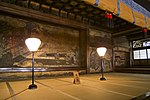
|
| Hiunkaku ( 飛雲 閣 ) | Nishi Honganji | South and north side: 25.8 m, east side: 11.8 m, west side: 12.5 m, three-story with shingle roof; Ground floor: shoin-zukuri , study ( 招賢 殿 , Shōkenden ), room of the eight beautiful landscapes ( 八景 之間 , Hakkei no ma ), veranda and a room for the tea ceremony ( 憶 昔 , ikujaku ); karahafu verge on one side and irimoya- style roof on the opposite side; |
Momoyama period , between 1573-1614 or 1624-1644 | Kyoto , Kyoto Prefecture |

|
| Taian ( 待 庵 ) | Myōkian ( 妙喜 庵 ) | 3 × 3.3 m, 2 tatami mats, large tea room (chashitsu) , vestibule ( 次 の 間 , tsugi-no-ma ) the size of a tatami mat, which, unlike the usual design, has a wooden core ( 板 畳 , itadatami ) ; one-story, shingle roof in kirizuma-zukuri style, plus a pent roof over the entrance; oldest preserved tea house in Japan, designed by Sen no Rikyū | Momoyama time , Tenshō time | Ōyamazaki , Kyoto Prefecture |

|
| Shoin ( 書院 ) | Ryōkō-in ( 竜 光 院 ) ( Daitoku-ji ) | Dimensions 6 × 4 ken, one-story, yosemune-zukuri style; four rooms with ten, eight, six and four and a half tatami mats, large veranda, with a 4.5 + 3/4 tatami mat large tea room (chashitsu) denoted by mittan-seki ( 密 庵 席 ); built by Kuroda Nagamasa | early Edo period , chashitsu from the Kan'ei period | Kyoto , Kyoto Prefecture | |
| Former Palace of the Crown Prince ( 旧 東宮 御所 , Kyū-Tōgūgosho ) | Akasaka Palace Guest House ( 迎賓館 赤 坂 離宮 , Geihinkan Akasaka rikyū ) | Neo-Baroque style, designed by Katayama Tōkuma , former residence of Crown Prince Haru-no-miya Yoshihito ( 明 宮 嘉仁 ), later Taishō-Tennō | late Meiji period , 1909 | Tokyo |

|
literature
- David Young, Michiko Young: The art of Japanese architecture . In: Architecture and Interior Design . Tuttle Publishing, 2007, ISBN 978-0-8048-3838-2 (English, limited preview in Google Book Search [accessed January 30, 2011]).
- David Young, Michiko Young, Tan Hong Yew: Introduction to Japanese architecture . In: Periplus Asian architecture . Tuttle Publishing, 2004, ISBN 0-7946-0100-6 (English, limited preview in Google Book Search [accessed January 30, 2011]).
- Kazuo Nishi, Kazuo Hozumi: What is Japanese architecture? In: Periplus Asian architecture . Kodansha International, 1996, ISBN 4-7700-1992-0 (English, limited preview in Google Book Search [accessed January 30, 2011]).
Web links
Individual evidence
- ^ Cultural Properties for Future Generations. (PDF; 1.1 MB) Office for Cultural Affairs , March 2011, archived from the original on August 13, 2011 ; Retrieved February 1, 2012 .
- ↑ a b c 国 指定 文化 財 デ ー タ ベ ー ス (Database of National Cultural Assets). Office for Cultural Affairs, November 1, 2008, accessed November 30, 2012 (Japanese).
- ↑ 国宝 ・ 重要 文化 財 (建造 物) の 指定 に に つ い て . (PDF; 624 kB) Office for Cultural Affairs, October 16, 2009, archived from the original on October 8, 2010 ; Retrieved February 1, 2012 (Japanese, On Appointment of National Treasures and Important Cultural Goods in the Structures and Buildings Main Category ).
- ↑ a b c d Young, David; Young, Michiko: The art of Japanese architecture. Architecture and Interior Design, 2007, p. 80.
- ↑ Young, David; Young, Michiko: The art of Japanese architecture. Architecture and Interior Design, 2007, p. 81.
- ↑ a b c d e shoinzukuri. Jaanus - Japanese Architecture and Art Net User System, accessed November 19, 2012 .
- ↑ Young, David; Young, Michiko: The art of Japanese architecture. Architecture and Interior Design, 2007, p. 79.
- ↑ shoin. Jaanus - Japanese Architecture and Art Net User System, accessed November 17, 2012 .
- ↑ Nishi, Kazuo; Hozumi, Kazuo: What is Japanese architecture? 2009, p. 76.
- ↑ Young, David; Young, Michiko: The art of Japanese architecture. Architecture and Interior Design, 2007, p. 81.
- ↑ Nishi, Kazuo; Hozumi, Kazuo: What is Japanese architecture? 2009, p. 75.
- ↑ souan. Jaanus - Japanese Architecture and Art Net User System, accessed November 25, 2012 .
- ↑ a b Young, David; Young, Michiko Kimura; Yew, Tan Hong: Introduction to Japanese architecture. 2004, p. 63.
- ↑ Young, David; Young, Michiko: The art of Japanese architecture. Architecture and Interior Design. 2007, p. 90.
- ↑ a b c sukiyazukuri. Jaanus - Japanese Architecture and Art Net User System, accessed November 17, 2009 .
- ↑ Young, David; Young, Michiko Kimura; Yew, Tan Hong: Introduction to Japanese architecture. 2004, p. 100.
- ↑ Nishi, Kazuo; Hozumi, Kazuo: What is Japanese architecture? 2009, p. 78.
- ↑ 国 指定 文化 財 デ ー タ ベ ー ス . In: Database of National Cultural Properties. The Office for Cultural Affairs, November 1, 2008, accessed November 28, 2012 (Japanese).
- ↑ 名 鉄 犬 山 ホ テ ル 有 楽 苑 / 如 庵 (Hotel Meitetsu in Inuyama, Urakuen / Joan). Meitetsu Inuyama Hotel, accessed November 14, 2012 (Japanese).
- ↑ a b c irimoya-zukuri. JAANUS - Japanese Architecture and Art Net User System, accessed February 1, 2012 .
- ↑ 三井 寺 勧 学院 客 殿 (Mii-dera, Kangakuin, reception room). Mii-dera, accessed February 1, 2012 (Japanese, including image).
- ↑ a b Hans Koepf : Pictorial dictionary of architecture . 2nd Edition. Kröner, Stuttgart 1985, ISBN 3-520-19402-3 , pp. 451 .
- ↑ a b c karahafu. JAANUS - Japanese Architecture and Art Net User System, accessed February 1, 2012 .
- ↑ 光 浄 院 客 殿 (Kōjōin reception area). Mii-dera, accessed February 1, 2012 (Japanese).
- ↑ a b World Heritage Kyoto Daigoji Temple: Guide to Daigoji Complex Guide to Sanboin. Daigo-ji , 2008, accessed February 1, 2012 .
- ↑ omote. JAANUS - Japanese Architecture and Art Net User System, accessed on February 1, 2012 (English, especially section 2): “ Most had a formal entry porch, genkan 玄関 , and one or more shoin 書院 style reception rooms, which had a decorative alcove tokonoma 床 の 間 "
- ↑ sangawarabuki. JAANUS - Japanese Architecture and Art Net User System, accessed November 10, 2012 .
- ↑ karamon. JAANUS - Japanese Architecture and Art Net User System, accessed on February 1, 2012 (English, with arched verge and arched rafter ).
- ↑ chokushimon. JAANUS - Japanese Architecture and Art Net User System, accessed November 24, 2012 .
- ^ The Silver Pavilion or Kannon Hall. Shokoku-ji , archived from the original on July 20, 2011 ; Retrieved February 1, 2012 .
- ↑ katoumado. JAANUS - Japanese Architecture and Art Net User System, accessed November 21, 2012 .
- ↑ hougyou-zukuri. JAANUS - Japanese Architecture and Art Net User System, accessed October 21, 2012 .
- ^ Hall of the Eastern Quest. Shokoku-ji , archived from the original on July 20, 2011 ; Retrieved November 20, 2012 .
- ↑ 遠 侍 . In: デ ジ タ ル 版 日本人 名 大 辞典 + Plus at kotobank.jp. Kodansha, 2009, accessed October 30, 2012 (Japanese).
- ↑ a b c d e f 元 離宮 二条 城 (Palace and Castle Nijō). Kyōto, archived from the original on January 25, 2012 ; Retrieved February 1, 2012 .
- ↑ Shikidai. JAANUS - Japanese Architecture and Art Net User System, accessed on February 1, 2012 (English, A wooden platform or step from 40 cm to 2 m, which became part of the Genkan , the entrance area, at the end of the 17th century and which was also used for parking a sedan chair.).
- ↑ Hiroma. JAANUS - Japanese Architecture and Art Net User System, accessed on February 1, 2012 (English, especially Section 6).
- ↑ a b c 本 願 寺 (西 本 願 寺) (Hongan-ji (Nishi Hongan-ji)). Nishi Hongan-ji , archived from the original on October 18, 2009 ; Retrieved November 14, 2009 (Japanese).
- ↑ 黒 書院 (Black Study Hall). Nishi Hongan-ji , archived from the original on October 20, 2009 ; Retrieved November 21, 2012 (Japanese).
- ↑ yosemune-zukuri. JAANUS - Japanese Architecture and Art Net User System, accessed November 8, 2012 .
- ↑ ryousage-zukuri. JAANUS - Japanese Architecture and Art Net User System, accessed November 8, 2009 .
- ↑ 対 面 所. Meeting room. Nishi Hongan-ji , archived from the original on June 25, 2009 ; Retrieved November 14, 2009 (Japanese).
- ↑ 白 書院 . Nishi Hongan-ji , archived from the original on August 17, 2009 ; Retrieved November 14, 2009 (Japanese).
- ↑ nure-en. JAANUS - Japanese Architecture and Art Net User System, accessed November 10, 2012 .
- ↑ 飛雲 閣 (Flying Cloud Pavilion). Nishi Hongan-ji , archived from the original on June 24, 2009 ; Retrieved November 14, 2009 (Japanese).
- ↑ hiunkaku. JAANUS - Japanese Architecture and Art Net User System, accessed November 9, 2009 .
- ^ Taian Teahouse. artofjpn, archived from the original on August 21, 2009 ; Retrieved November 23, 2012 .
- ↑ 待 庵 (Taian). goo, accessed November 23, 2012 (Japanese).
- ↑ 塔 頭 大仙 院 ・ 龍 光 院 を 含 む . 国宝 建造 物 編 №50 , accessed November 18, 2012 (Japanese).
- ↑ 迎賓館 赤 坂 離宮 (State Guest House, Akasaka Palace). Cabinet Office Government of Japan, archived from the original on November 20, 2012 ; Retrieved November 22, 2012 .
Remarks
- ↑ a b c d e f g h i j k l The national treasures of Nijō Castle and the Ninomaru Palace form a coherent complex, which is summarized as a national treasure under a registration number. For the sake of clarity, they are listed separately in this table.
- ↑ a b c d e The Akasaka Imperial Residence in Tokyo is the only modern building ( Meiji period and later) that has been declared a national treasure. All other buildings are much older and date from the late 15th to early 17th centuries.
- ↑ If the time of origin of a residence extends over several time periods, the earliest is always given.
- ↑ As usual in Japan, the ground floor is counted as the first floor, i.e. H. a two-story building therefore has a ground floor and a first floor according to European standards.
- ↑ a b A ken ( 間 ) is a Japanese measure of length that is approximately 1.81 m.
- ↑ a b c d In the Tsumairi style ( 妻 入 造 , tsumairi-zukuri), the entrance is on the side of the building on which the foot hip is, whereby the axis for the passage has the same direction as the roof ridge . If you enter through an entrance that is at right angles to the ridge of the roof, it is the Hirairi style ( 平 入 造 , ~ -zukuri).
- ↑ a b c d kirizuma-zukuri. JAANUS - Japanese Architecture and Art Net User System, accessed February 1, 2012 .
- ↑ a b Included in the nomination as a national treasure is a munafuda ( 棟 札 ), a 30 cm to 1 m long wooden plaque , here showing the date of construction.
- ↑ a b c d e f g h i j k The Irimoya style, ( 入 母 屋 造 , irimoya-zukuri ) combines the triangular gable of a gable roof in the upper roof area with the gable-like shape of a hipped roof in the lower area of the roof.
- ↑ Sangawarabuki , 桟 瓦 葺 : is a combination of a concave, arched, wide roof plate and a semi-cylindrical, cylindrical tile. The entire roof panel is square and curved from concave to convex, undulating.
- ↑ a b c Is a wave-shaped gable, the shape of which is determined by a convex verge.
- ↑ hōgyō style ( 宝 形 造 , hōgyō-zukuri ): pyramidal roof on a building with a square floor plan
- ↑ a b c d e f g With this type of roofing, concave roof tiles ( 平 瓦 , hiragawara ) are combined with cylindrical tiles ( 丸 瓦 , marugawara ) on the abutting edges .
- ↑ An attached room and a connecting passage between shiroshoin and kuroshoin included in the nomination as a national treasure .
- ↑ a b yosemune-zukuri ( 寄 棟 造 ): Hipped roof with trapezoidal front and back and triangular sides
- ↑ The Ryōsage style ( 両 下 造 ) is a gable roof without a gable, as other roof structures are attached.
- ↑ Similar to the cabinet or salon in Europe, the Taimenjo is an audience hall in the houses and residences of the samurai, in order to receive people formally, especially taking into account their rank relative to their own person.
- ↑ Designates a pyramidal roof structure over a building with a square floor plan. The roof has no rafters.


